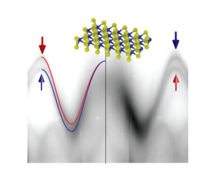Philip Hoffman & Jeppe V. Lauritsen
Let the electrons spin

The next generation of electronics needs new materials. Researchers at Aarhus University have now not only succeeded in doing away with the wrong assumptions about these material properties, but have also contributed to moving from an ambitious theory to tangible physics, where two-dimensional materials could ultimately create a platform for the electronics of the future.
Many people recognise molybdenum disulphide as an excellent lubricant for bicycle chains and other purposes, but the Aarhus University researchers have now also proved that the material can make for smoother development. Aarhus University and the Interdisciplinary Nanoscience Centre (iNANO) have considerable experience in producing nanocrystals and using the material for research into catalysts in collaboration with Danish industry.
In a collaboration between Jeppe Vang Lauritsen’s and Philip Hofmann’s research groups, researchers have now succeeded in getting the nanocrystals to grow together and produce a two-dimensional layer of the material. The Aarhus researchers are also the first to show that measurements of the behaviour of the electrons is consistent with the theories of spin polarisation.
To read the article at Scitech
For more information, please contact
Professor Philip Hofmann
Department of Physics and Astronomy
Aarhus University
+45 2338 2343
philip@phys.au.dk
Assoc. Prof. Jeppe Vang Lauritsen
iNANO - Aarhus University
+45 23382369
jvang@inano.au.dk
